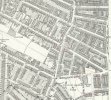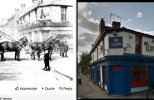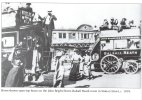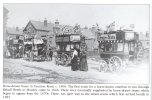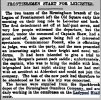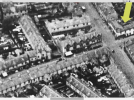mike the clifton pub looks a bit different now..well this is it when they shot the youtube videoI do not like colourised photos, a swe cannot be sure colours are right, and the definition is usually decreased by the colourization. but they do not fake the happening. However .AI seems to be more and more apparent recently. There have been a number of "new " photos appeared recently that I believe are not real. The latest is this one labelled "Ladypool Road, Sparkbrook - Clifton Pub on the right". As the methods improve it will soon be impossible to tell if a photo is real or the product of someone's imagination
View attachment 207615
-
Welcome to this forum . We are a worldwide group with a common interest in Birmingham and its history. While here, please follow a few simple rules. We ask that you respect other members, thank those who have helped you and please keep your contributions on-topic with the thread.
We do hope you enjoy your visit. BHF Admin Team
You are using an out of date browser. It may not display this or other websites correctly.
You should upgrade or use an alternative browser.
You should upgrade or use an alternative browser.
Fake Photos
- Thread starter mikejee
- Start date
Radiorails
master brummie
BHF has. its seems, up to now, been a good source of Birmingham's history and has contained some fine, usually, photographs which often accompany that history adding interest a detail to the post that is made.
However with recent technology it is becoming apparent that certain photographs and the details relevant to it maybe suspect regarding its origin.
With reference to post 1#, Mike's comment about a persons imagination is certainly to the point. I feel that we, on BHF, should be aware of future technological developments.
However with recent technology it is becoming apparent that certain photographs and the details relevant to it maybe suspect regarding its origin.
With reference to post 1#, Mike's comment about a persons imagination is certainly to the point. I feel that we, on BHF, should be aware of future technological developments.
Last edited:
Pedrocut
Master Barmmie
Thanks Chris,
The third photo is definitely a fake, but would have been nice if it had struck to the true detail. Shame it didn’t.
I think the answer lies in that pixel to pixel comment. There seem to be more expensive apps and perhaps we get what we pay for.
Many on the Forum have been pleased with the attempts by members to descratch and enhance their family photos.
The third photo is definitely a fake, but would have been nice if it had struck to the true detail. Shame it didn’t.
I think the answer lies in that pixel to pixel comment. There seem to be more expensive apps and perhaps we get what we pay for.
Many on the Forum have been pleased with the attempts by members to descratch and enhance their family photos.
I think it is desirable that people put the source of posted photographs wherever possible. It is certainly useful to discuss the status of images in the spirit of friendly inquiry.
Manipulated images are as old as photography itself, but AI introduces new or at least more intense issues. Once an image becomes questionable then as here, more questions arise. This is healthy if it is done without malice.
Some of the AI tools are designed for auto-moderation, but we are in the early stages and need to use our own knowledge.
'Fake' is a loaded word, elements of #1 clearly existed, but probably have been collaged together and perhaps the combined image has had some Al work too? Those missing or extra legs? Perhaps an original or originals will emerge? We are fortunate to be able to see as many historical photographs as we can rather than them being discarded when houses are cleared.
Manipulated images are as old as photography itself, but AI introduces new or at least more intense issues. Once an image becomes questionable then as here, more questions arise. This is healthy if it is done without malice.
Some of the AI tools are designed for auto-moderation, but we are in the early stages and need to use our own knowledge.
'Fake' is a loaded word, elements of #1 clearly existed, but probably have been collaged together and perhaps the combined image has had some Al work too? Those missing or extra legs? Perhaps an original or originals will emerge? We are fortunate to be able to see as many historical photographs as we can rather than them being discarded when houses are cleared.
Pedrocut
Master Barmmie
Whether you consider the Post1 picture a fake or not it does show some Birmingham history that has not been brought up before.
The omnibus is a an example of Birmingham horse drawn omnibus similar to the one shown below from the Frith Collection in New Street.
From the picture we can learn the route from Birmingham High Street passing down the Stratford Road from the Sip Inn at Camp Hill and past Ladypool Road and on to the other places.
Why is it off course by the Clifton Inn? We may have a picture of an old version of the Clifton Inn ?
Priory tea is a local company founded 1893
.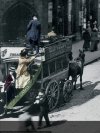
The omnibus is a an example of Birmingham horse drawn omnibus similar to the one shown below from the Frith Collection in New Street.
From the picture we can learn the route from Birmingham High Street passing down the Stratford Road from the Sip Inn at Camp Hill and past Ladypool Road and on to the other places.
Why is it off course by the Clifton Inn? We may have a picture of an old version of the Clifton Inn ?
Priory tea is a local company founded 1893
.

Last edited:
Brummie a long time ago
master brummie
I am old (fashioned) but for me, the image presented should be what went in through the camera lens. I take few photos with my phone because of the automatic processing done before an image is saved. I don't have an issue with machine generated images, if they are presented as such on the basis of "look what I achieved with a creative prompt", but item 1 in ChrisM's post #26 makes me boil.
When it is done for political ends, in the knowledge that most people still think that the camera does not lie, then it is hard not to scream in despair.
Andrew.
When it is done for political ends, in the knowledge that most people still think that the camera does not lie, then it is hard not to scream in despair.
Andrew.
ChrisM
Gone but not forgotten R.I.P
I think it is desirable that people put the source of posted photographs wherever possible. ........
That's something which we've never been very good at. Better here perhaps than the rest of social media, especially Fb. But pretty rare nevertheless, despite whatever good intentions and conscientiousness any of us might have.
Quite apart from the new dangers arising from the arrival of AI, it's a courtesy not only to the original owner who may have put a heck of a lot of work into making the image available in the first place; but also to the person viewing - who, for his/her personal reasons, would like a quick route back to origins and the possibility of additional information. (What I'm talking about here is mainly personal images filched from online sources and books; and less about the more generic stuff like Frith postcards, newspaper cuttings etc. whose origins are more easily guessed at).
Chris
yes pedro its definately the clifton inn...note the fluted design going all the way round..windows and doors the same also so the location is correct..
lyn
yes we can pedro you have to look hard but its thereJust noticed that you can actually make out Clifton Inn, Butlers !
lyn
I would like to encourage people to post images for discussion without imputing blame. We don't know who created the picture posted on FB or why. I think with a view camera with movements you might be able to make a similar image in a darkroom. An image of the bus and horses might appear empty at the horse end so drop in a picture of the pub.I would agree with much of what you say Stokie. But , to me, the mixing of two parts of a photograph, probably from different places, is undoubtably a fake. as much as if the entire photograph is an imagined view
These days, it could be done digitally for a laugh, for a sense of nostalgia, evoking 'heritage' and I suspect that colouring is often added to make them more 'relatable' - of course Victorian photographers sometimes hand coloured their work.
Most photos of people at work are posed and this photo certainly is. I thought this image raised an interesting discussion and some questions. I would be more tolerant if the image was made in 1920 than if everything was digitally created in 2019! Some photographers have always thought of themselves as artists rather than making documentary history.
Hand-coloured or digitally colourised? I'm not using the F word.Whether you consider the Post1 picture a fake or not it does show some Birmingham history that has not been brought up before.
The omnibus is a an example of Birmingham horse drawn omnibus similar to the one shown below from the Frith Collection in New Street.
From the picture we can learn the route from Birmingham High Street passing down the Stratford Road from the Sip Inn at Camp Hill and past Ladypool Road and on to the other places.
Why is it off course by the Clifton Inn? We may have a picture of an old version of the Clifton Inn ?
Priory tea is a local company founded 1893
.View attachment 207673
BrummieGeoff
Sparkhill Lad
The photo was included in a 2019 post on Graham Knight's excellent FB page "Birmingham Old Prints, Photographs and Maps 1600-1900's". I believe that Graham was an active member of this Forum in the past, and I suspect many of us followed his FB page before it was suspended due to his ill health. We can all be misled by incorrect photo descriptions and dates, but I consider Graham's page to be consistently reputable and informative .... and certainly more reliable than many of the FB groups.It is a pity then that the person who put the September 2019 picture on Facebook did not reveal the source.
Is it possible to check this on Facebook ?
It is difficult to be certain about the authenticity of the photo, and it does look as though it has been "enhanced" to sharpen and contrast the foreground. However, I make the following observations:
1. I don't think today's AI tools were in common use in 2019.
2. If it has been constructed from 2 separate background and foreground images, it's strange that none of us have seen those images elsewhere.
3. The "3-legged" boy on the right, looks more like 2 boys standing together.
4. The bus has no passengers and doesn't appear to be in active service. Therefore, it's presence on Ladypool Road (off it's advertised route) may indicate that it's going to/from its depot/yard .... or posed there to make a good photo.
I fully understand the concerns about "false history". But personally I share Pedrocut's view that it gives us a great image of a horsedrawn omnibus from Birmingham's past .... that I find fascinating. And it has prompted me to search out more details - which is great.
Last edited:
Lyn, if there are originals then this would be the glass plate or negative. But the image might be enlarged, made darker or lighter or even reversed. Portrait photographers often used to flip the image so that we see our faces as we see ourselves in the mirror and not as we are seen by others. If we are given a choice then we will often select the mirror image as best. Sometimes only part of a negative might be printed. It could be that the pub background was introduced to fill up an empty space! Make the picture more balanced... I do like monochrome photography, they are a sort of abstraction pure light and shadow. While we might desire straight documentary photography on BHF people actually take photos for all sorts of reasons and often not to document history. We might put on our best clothes and pose in an artificial studio. Some of my ancestors certainly did. I'm not defending F for fake, just trying to explore how photography might be thought about. Derekpersonally i think that if anything is added or indeed taken away from any photograph then its not original..the taking away of creases in very old photographs (which is very clever) is restoration and ok with me...
lyn
Excellent Geoff! You have greatly added to our knowledge of the image. I suspect that it could be created by a skilled photographer using a view camera, that is a large plate camera with movements enabling the lens to focus on the bus and horses with a big enough image circle to include the pub. No collage or other image required, but a skilled printer. Older photographs often have a different perspective than the cameras or phones we are used to. I'd expect all professional work to be 'enhanced' to sharpen and contrast the subject. DerekThe photo was included in a 2019 post on Graham Knight's excellent FB page "Birmingham Old Prints, Photographs and Maps 1600-1900's". I believe that Graham was an active member of this Forum in the past, and I suspect many of us followed his FB page before it was suspended due to his ill health. We can all be misled by incorrect photo descriptions and dates, but I consider Graham's page to be consistently reputable and informative .... and certainly more reliable than many of the FB groups.
It is difficult to be certain about the authenticity of the photo, and it does look as though it has been "enhanced" to sharpen and contrast the foreground. However, I make the following observations:
1. I don't think today's AI tools were in common use in 2019.
2. If it has been constructed from 2 separate background and foreground images, it's strange that none of us have seen those images elsewhere.
3. The "3-legged" boy on the right, looks more like 2 boys standing together.
4. The bus has no passengers and doesn't appear to be in active service. Therefore, it's presence on Ladypool Road (off it's advertised route) may indicate that it's going to/from its depot/yard.
I fully understand the concerns about "false history". But personally I share Pedrocut's view that it gives us a great image of a horsedrawn omnibus from Birmingham's past .... that I find fascinating. And it has prompted me to search out more details - which is great.
Just to add something. I feel it is not just the bus that has been added, but also the buildings to the left. the maps below show the junction in 1887 and and a larger scale 1902-3. Clifton pub in red, arrow approx position of camera. Neither map corresponds to the buildings on the left. The process has been done by sliding the left had side into the right hand side, in the same way that some images have been produced showing a street half of which as a a historical photo, and the other half as a modern photo
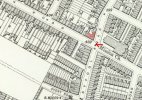
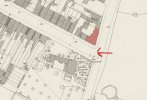


Well Mike, we are back to photomontage then. I hope a historic one and for artistic rather than documentary purposes. I see no reason to think this is the result of photoshop or any digital process, just competent darkroom work. I think the photomontage could well have been done in the early 1900s, perhaps even as advertising or a celebration of some event. Could be wrong of course. The metadata of the original JPEG might reveal if there are different layers, but we are probably dealing with a photograph of a photograph. Perhaps this could be the sort of 'heritage image' that pubs buy to create a historic atmosphere.Just to add something. I feel it is not just the bus that has been added, but also the buildings to the left. the maps below show the junction in 1887 and and a larger scale 1902-3. Clifton pub in red, arrow approx position of camera. Neither map corresponds to the buildings on the left. The process has been done by sliding the left had side into the right hand side, in the same way that some images have been produced showing a street half of which as a a historical photo, and the other half as a modern photo
View attachment 207681View attachment 207683
Derek
Last edited:
BrummieGeoff
Sparkhill Lad
For reference, here's a later aerial view of the scene dated 1946 .... the Clifton pub is indicated by the arrow.Just to add something. I feel it is not just the bus that has been added, but also the buildings to the left. the maps below show the junction in 1887 and and a larger scale 1902-3. Clifton pub in red, arrow approx position of camera. Neither map corresponds to the buildings on the left. The process has been done by sliding the left had side into the right hand side, in the same way that some images have been produced showing a street half of which as a a historical photo, and the other half as a modern photo
View attachment 207681View attachment 207683
Credit: Historic England
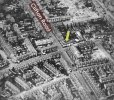
Pedrocut
Master Barmmie
Pedrocut
Master Barmmie
Just to add something. I feel it is not just the bus that has been added, but also the buildings to the left. the maps below show the junction in 1887 and and a larger scale 1902-3. Clifton pub in red, arrow approx position of camera. Neither map corresponds to the buildings on the left. The process has been done by sliding the left had side into the right hand side, in the same way that some images have been produced showing a street half of which as a a historical photo, and the other half as a modern photo
View attachment 207681View attachment 207683
The top map shown is 1902/3 and the lower 1887.
On the lower (1887) it shows Acacia House which lying iside gardens. The development of Ladypool Road seems to have led to the demise of Acacia House by 1903.
Pedrocut
Master Barmmie
We see in post 55 that the Birmingham Omnibus Co. has horses that daily work the omnibuses on the Ladypool Road route from their depot at Sparkbrook. This depot was situated in Taunton St as shown on the map below. It therefore seems highly likely that their omnibus would at times appear near the Clifton Inn.
